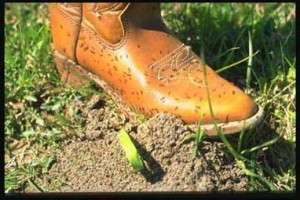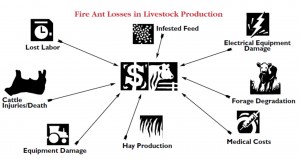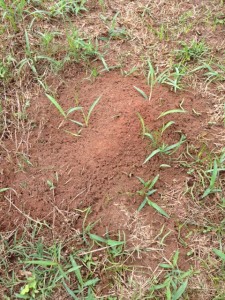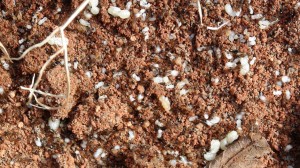
When it comes to Agricultural Operations, Imported Fire Ants are more than just a biting pest. (Photo by Dr. Bastiaan “Bart” Drees, Statewide Extension Program Specialist Texas A&M University)
Fire ants attack anything that disturbs their mound (nest), including livestock and humans. They firmly grasp skin with their jaws, and then sting and inject venom. Fire ants pivot at the head and inflict more stings in a circular pattern. Two species of imported fire ants were accidentally introduced into the southern United States from South America in the early 1900’s. The red imported fire ant and the black imported fire ant.
Fire ant mounds in hay fields can cause equipment breakdowns when cutting machinery hits tall hardened mounds. The ants may also consume seeds or seedlings of some forage crops. In pasture situations imported fire ant workers can quickly recruit other ants from their colony to food and moisture resources. Newborn livestock and wildlife, birds hatching from eggs and confined animals are particularly vulnerable to attack by imported fire ants.

Fire Ants are a costly agricultural pest. (Image from the Alabama A&M and Auburn Universities Publication Publication: Management of Imported Fire Ants in Cattle Production Systems.)
Methods of managing this pest are determined by their location: hayfield, pasture, structure, home. A number of different control methods are available and are most successfully used when they are part of an Integrated Pest Management (IPM) program. For example, the following is from the publication “Fire Ant Control: The Two-Step Method and Other Approaches:”
Types of Control
- Biological control: Government and university researchers have imported and tested natural enemies of fire ants, such as parasitic decapitating flies from South America. These natural enemies have been successful in areas where they have been released but they are not available to the general public. However, ongoing release programs in all infested states are making decapitating flies more prevalent in the environment. Biological control agents available on the retail market, such as parasitic nematodes, do not sustain themselves or spread on their own once they are released.
- Home remedies: Many home remedies have been devised to control fire ants. Drenching a mound with two to three gallons of almost boiling water eliminates ant colonies about 60 percent of the time, but it will also kill plants the water contacts. This method is labor intensive and the hot water must be handled carefully. Some home remedies, such as applying instant grits, molasses, aspartame or club soda to ant mounds, do not work. Pouring chlorine, ammonia, gasoline or diesel fuel on mounds can contaminate the soil and groundwater, is dangerous, and is strongly discouraged.
- Organic products: A few products are certified as organic. These include ingredients such as d-limonene, an extract from citrus oil, or spinosad, a chemical complex produced by a soil microbe.
- Chemical control: The use of insecticides for fire ant control is regulated by the Environmental Protection Agency. Approved products must be used according to label directions. Read the label carefully! An approved product is one that has directions for fire ant control on the label. Be sure it is appropriate for where you intend to use it, particularly if you will be treating a vegetable garden or other food production site. Products for use in electrical utility boxes and indoors may not be available at retail stores and some products are for use only by professional pest control operators.
For more information on controlling fire ants please see the following publications:
Alabama A&M and Auburn Universities: Management of Imported Fire Ants in Cattle Production Systems
e-Extension: Fire Ant Control: The Two-Step Method and Other Approaches
Texas A&M Agrilife Extension: March 2013 Update of Fire Ant Control Products
- 54th Annual Santa Rosa County Farm Tour Goes Virtual - December 11, 2020
- Video Tour of the 2020 Santa Rosa County Peanut Variety Trial - October 9, 2020
- Giant Salvinia – A Highly Invasive Aquatic Plant You Don’t Want Growing in Your Pond - May 29, 2020


